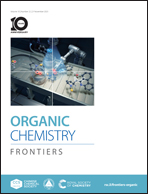Why is phenyl azide so unreactive in [3 + 2] cycloaddition reactions? Demystifying Sustmann's paradigmatic parabola†
Abstract
The [3 + 2] cycloaddition (32CA) reactions of phenyl azide with a series of 25 ethylenes of different electronic activation have been studied within Molecular Electron Density Theory (MEDT) at the ωB97X-D/6-311G(d,p) computational level to understand the low reactivity of azides participating in 32CA reactions. Analysis of the reactivity indices allows characterizing phenyl azide as a moderate electrophile and a moderate nucleophile. The relative reaction rate constants kr of twelve selected 32CA reactions, together with the electrophilicity ω and nucleophilicity N indices of the corresponding ethylenes, allow us to classify these 32CA reactions into four groups: (i) group A, involving supernucleophilic ethylenes and displaying a kr > 104; (ii) group B, involving strained cyclic ethylenes and displaying a kr < 102; (iii) group C, involving strongly electrophilic ethylenes and displaying a kr ≤ 102, and (iv) group D, involving moderately electrophilic and nucleophilic ethylenes and displaying a kr < 2. These four groups are characterized in Sustmann's “parabolic correlation”, which results from an inaccurate interpretation of the reactivity of phenyl azide, which is not an “ambiphilic species” but rather a moderate electrophile that reacts efficiently only with supernucleophilic ethylenes in reverse electron density flux (REDF) zw-type 32CA reactions.
![Graphical abstract: Why is phenyl azide so unreactive in [3 + 2] cycloaddition reactions? Demystifying Sustmann's paradigmatic parabola](/en/Image/Get?imageInfo.ImageType=GA&imageInfo.ImageIdentifier.ManuscriptID=D3QO00811H&imageInfo.ImageIdentifier.Year=2023)
- This article is part of the themed collection: Celebrating the scientific accomplishments of RSC Fellows


 Please wait while we load your content...
Please wait while we load your content...